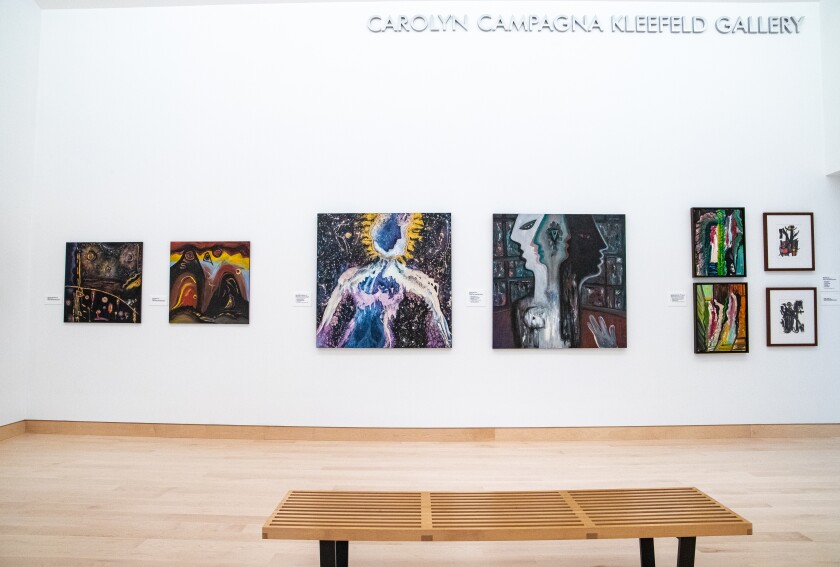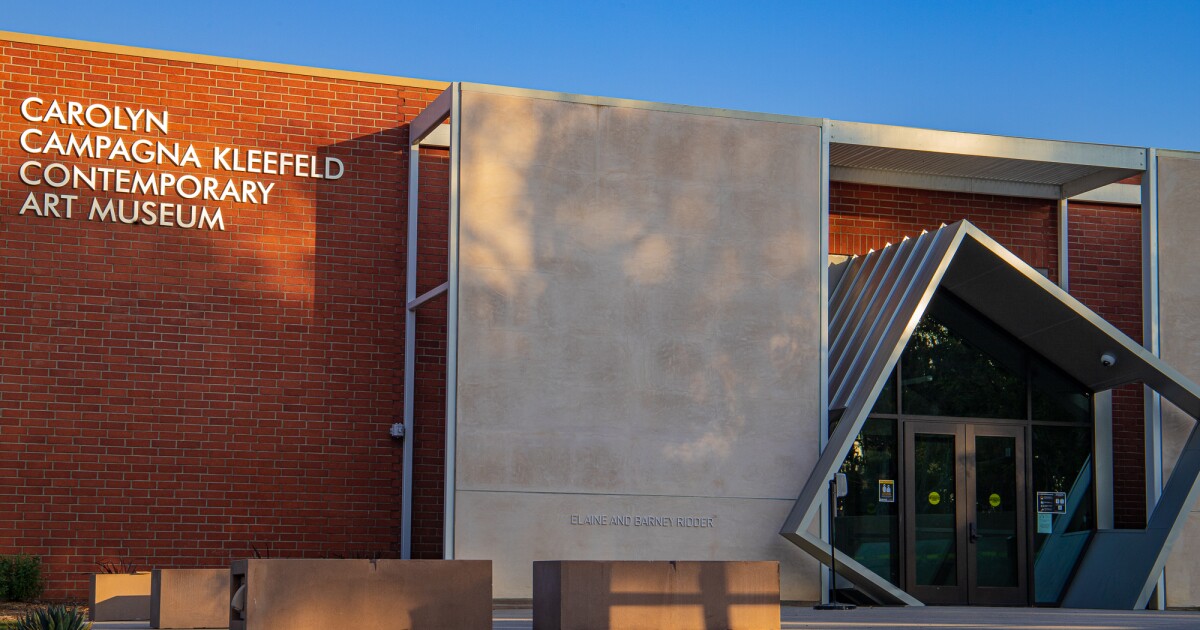The other day, I drove over to Cal State Long Beach and saw an exhibition of Carolyn Campagna Kleefeld’s paintings and drawings from the last 30 years, which are on view inside the Carolyn Campagna Kleefeld Gallery at the newly expanded and renamed Carolyn Campagna Kleefeld Contemporary Art Museum.
If you think this nesting doll of names is odd, even in our era of bloated naming opportunities at cultural institutions, you would be right. I’ve never seen anything quite like it. In Los Angeles, every third arts building seems to be named Geffen or Broad, while in San Diego it’s the Jacobs moniker that’s over many a front door. Fine. Rarely, however, do big, raised letters of a naming opportunity inside a museum room identify the same donor whose name is also in big, raised letters on the edifice outside. Virtually never is the art on view made by the same-named patron.
Welcome to Long Beach. Here at Cal State University, Kleefelds in the Kleefeld at the Kleefeld are the new norm. Disturbingly so. It’s a train wreck, and a serious disservice is being done to students.
The show, which features 10 canvases and 13 works on paper, is a small selection from a gift that the artist made to the museum, including 74 of her paintings and 104 of her drawings. Kleefeld art is now about 6% of the museum’s permanent collection. (I’m unaware of its presence in any other museum’s collection.) Her own art will rotate in her dedicated gallery. Also donated were her library, a personal archive and copies of more than 20 inspirational books she has written.
Did I mention the $10-million check? That came too.
Cal State Long Beach raised $24 million to expand and refurbish the former University Art Museum, in operation since 1973, by 4,000 square feet. (It reopened in February.) There are now three exhibition galleries rather than two, a works on paper archive, a classroom, expanded collection storage and a capacious entry hall. A vestibule features one painting and a large, inspirational wall text printed on plexiglass — both by Kleefeld.
“My life’s passion has been to create art from an unconditioned well of being and to inspire such a journey in others,” the toothache-inducing signage reports, proposing that an artist occupies the realm of spiritual aristocrat. “To live our ultimate purpose is to thrive in our soul’s calling, sculpting ourselves into our highest ideal so that we may give our best away.”

A dedicated gallery inside the CSULB art museum is for the display of the donor’s paintings.
(Tatiana Mata)
In the Kleefeld paintings in the Kleefeld gallery at the Kleefeld museum, what makes the “well of being” so peculiar is that the art is frankly terrible — by far the worst I’ve seen on display in a serious exhibition venue, public or private, for profit or nonprofit, in years. The creaky Romantic fantasy of the numinous artist, isolated from mundane labors, turning her back on the modern world to get in touch with higher truths, is on display. The fiction abounds in gift-shop-quality illustrations representing cosmic consciousness. (The artist, a longtime resident of Big Sur on the central California coast, has shown most often at the luxury Ventana Inn and Spa nearby.) Smeary rainbows, abstract faces sequestered inside expressionist faces, and crude landscapes of mountains and woodlands are splattered with random dribbles of color, like thrift-store Jackson Pollocks. Except not as good.
Despite an evidence-free university press release extolling her “highly acclaimed paintings,” Kleefeld is a visual artist of no distinction in the field. Her biography reflects no active participation in art’s larger cultural discourse. (Shows at a pricey resort and spa don’t count.) Kleefeld might have prominence in the inspirational or New Age self-help industry — “The Alchemy of Possibility: Reinventing Your Personal Mythology,” “Climates of the Mind: Poems and Philosophical Aphorisms” and “Soul Seeds: Revelations and Drawings” are among her small-press titles — but her artistic contribution is virtually nil.
One painting from 2007 shows a blue, melting female form flattened against a splattered dark brown plane, her head framed by a golden corona. The title is “Laura Huxley’s Departure.” I cannot say whether writer Aldous Huxley’s widow, a well-known self-help author and friend of the painter, went out at age 96 riding a burst of LSD, as she reported that her husband did before her. But Kleefeld’s bleary illustration of Huxley’s demise suggests it’s possible.
The 2010 painting hanging adjacent, titled “Of Each Other,” is itself a nesting-doll composition. Profile heads inserted inside profile heads are clumsy adaptations from Picasso 70 or 80 years ago. Matryoshka by way of Marie-Thérèse Walter illustrates human interconnection or, perhaps, multiple personalities.
A 1993 drawing titled “Living Space” is an indoor-outdoor aerial view of a tabletop, some potted plants, a couple of candlesticks and two women in profile, all rendered in wispy lines. The label says this greeting-card-quality doodle is made with pastel and colored pens on “imported paper,” which perhaps means the sheet floated in from an astral plane.
Carolyn Campagna Kleefeld, “Laura Huxley’s Departure,” 2007 (left), and “Of Each Other,” 2010.
(Tatiana Mata)
A CSULB professor, who spoke on condition of anonymity given the sensitivity of the matter, said of the exhibition, “If that was a student applicant’s portfolio, they wouldn’t get admitted to the program.” The university’s admired School of Art has roughly 2,000 students in graduate and undergraduate programs and a faculty of more than 30.
In the early 1960s, Kleefeld’s late father was a major cultural benefactor in L.A. If the name S. Mark Taper rings a bell, that’s because his donations helped build the Music Center, where a theater bears his name, plus the recently demolished Los Angeles County Museum of Art. Adjusted for inflation, those two gifts would today amount to more than $22 million.
Taper’s philanthropy did not arise from any known passion for theater, music or art. The Polish-born British home builder and banker, who died at 92 in 1994, immigrated to Southern California in the 1930s, and his existing wealth exploded as the region did after World War II. Taper was of a patrician generation who believed that, if one had the financial wherewithal, being a good citizen required chipping in with peers to enhance the quality of civic life — so, happily, he did.
The arts interest is in evidence in his two daughters. Kleefeld’s sister and late brother-in-law, Janice and Henri Lazarof, donated their impressive, highly personal collection of 130 Modern European paintings and sculptures to LACMA 15 years ago. The remarkable bequest included 20 Picasso paintings, seven Alberto Giacometti sculptures, two versions of Constantin Brancusi’s signature “Bird in Space” sculptures and works by Georges Braque, Wassily Kandinsky, Paul Klee and many more. Whether or not sibling rivalry played any part in the subsequent CSULB donation, the difference in the art’s relative significance is stark.
A gift deal that includes permanent maintenance of a big collection and an archive of the donor’s bad art, plus a gallery dedicated to its display, all in exchange for millions of dollars, makes it impossible not to think “pay to play.” According to Kleefeld Contemporary Director Paul Baker Prindle, who was not on staff when the deal was struck, the artist approached the university about making the paintings donation, and the school responded favorably, along with a request for a cash gift. The $10 million helped get the museum expansion built; about $7 million went toward construction, while other funds will endow operations and scholarships.
Repeated public record requests by email and telephone to the university regarding the donation were acknowledged but ultimately went unanswered prior to press time.
Installation view of the Kleefeld Gallery.
(Tatiana Mata)
Both uses for the gift are potentially beneficial. But the deal is badly flawed — perhaps irreparably. A permanent chunk of a public university’s tax-subsidized museum facility and artistic program has been effectively privatized to advance the personal interests of a wealthy patron. CSULB has now made a sizable commitment to continuing in perpetuity a worthless but high-profile art project.
What is the university teaching students through such an arrangement?
Nizan Shaked is head of the school’s museum studies program. Her recent book, “Museums and Wealth: The Politics of Contemporary Art Collections,” is an academic analysis of similar dilemmas. Although it doesn’t address CSULB, its subject is especially acute given the increasing number of museums that focus on art by living artists. Reached by telephone, Shaked declined to comment on the specific Kleefeld arrangement, but she did describe the situation succinctly: “This is posing a problem for me in terms of teaching best practices.”
I’ll bet. The dilemma is inescapable. It’s like a university science department establishing a lab to study fad diets promoted by Dr. Oz, funded by the pseudoscience-spouting celebrity.
Art museums today profess a cultural commitment to diversity, equity and inclusion, and CSULB has one of the most diverse student bodies of any public university in the nation. Four out of five students identify as BIPOC — Black, Indigenous and people of color — according to College Factual, an education data site. (Enrollment is nearly half Latino.) But the kids, both BIPOC and white, are being shown that private wealth will prevail in the public sphere, even in the absence of actual achievement. Cultural philanthropy that cements the privileged status quo rolls on.
How did the onerous deal come about? A 10-month window opened in late 2018, when the school’s then-University Art Museum was without a director. Kimberli Meyer was let go in September, while Baker Prindle, the new director, didn’t come on board (from the University of Nevada, Reno) until the following July. The Kleefeld arrangement, announced in April 2019, was negotiated by the university during the absence of museum leadership.
The deal was a colossal blunder. A public museum — especially at a public university with an admired School of Art that also trains future museum professionals — should focus its primary collecting and exhibition resources on two things: established artistic excellence and art, whether brand new or old and overlooked, that it believes shows promise of attaining that rank. If Cal State Long Beach thinks this is that, then difficulty teaching best practices isn’t the half of it.
For all the latest Entertainment News Click Here
For the latest news and updates, follow us on Google News.

